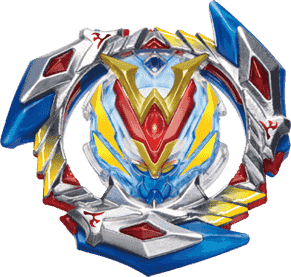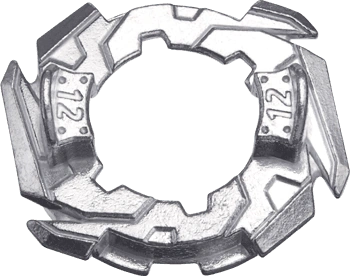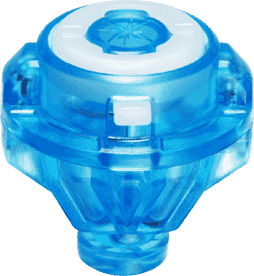Players who are already familiar with Beyblade Burst basics can read the following articles :
- Our Key Concepts article to help you understand how to assemble combinations and improve your tactics
- Our Advanced Techniques article to help you improve your skills and understanding of the game
- Our Beyblade Burst Sub-Systems article if you don’t know where or how to start your collection
The Basics
Beyblade Burst is the third generation of Beyblade. Created in 2015 by Hiro Morita, this third Beyblade saga came with a whole new universe, characters, and beys. Reading the manga and watching the anime is a part of what makes Beyblade Burst so special as a game, since a lot of beys characteristics or game mechanics are explained by the characters as the story goes on.
When it comes to the game itself, Beyblade Burst introduced a new mechanic : the Beyblades now have a “Burst” system, meaning that any Beyblade from this generation can explode after a significant impact, with its different parts being scattered around the arena.
It’s also fair to say that this generation puts an emphasis on style, aesthetics and gimmicks. Gimmicks are one of the reasons why kids can love Beyblade : if a Beyblade has a special move or a unique characteristic in the manga/anime, Takara Tomy will replicate it in real life. For example, if a Beyblade has an energy barrier in the anime, the toy will have rubber parts that extend under the effect of centrifugal force, creating the illusion that there’s indeed a barrier surrounding the Beyblade. Some gimmicks can affect gameplay, while some others don’t have much of an impact on the game.
It’s also worth noting that all the parts from the Takara Tomy toys are identical to those seen in the show, and their attention to details is remarkable.
Overall, Beyblade is fairly easy to play, but it also has depth, which is why it is easy to be confused when beginning, or simply missing out on nice features the game has to offer.
Our Wiki pages are designed to help players start their journey in Beyblade : this page will give access to everything players need to know to begin and improve their skills. Furthermore, our Wiki pages will give an overall description and analysis of every Beyblade Burst model and their components with two things in mind :
- Friendly Use : tips to keep the Beyblades balanced in terms of performance level for Bladers playing with friend and family. Keeping the game balanced is important ; if a Beyblades is too strong or too weak, it will break the game balance and ruin the game. Right out of the box, some Beyblades are pretty powerful while some others will struggle to win a single round. Our Wiki pages will help players to identify which parts can make the difference without changing the Layer (the Beyblade’s upper part). These tips are designed to improve the Beyblades seen in the anime while preserving their identity as much as possible.
- Competitive Use : when players are looking for a specific Beyblade or Component on our Wiki pages, each article will mention which parts are competitive. Furthermore, each Beyblade article features tips to create competitive combinations.
Beyblade Burst : The Rules
In the basic, non-competitive rules, the first player to score 3 points will be the winner. There are three ways to score :
Survivor Finish : if your opponent’s bey stops spinning before yours, it’s a survivor finish and you score 1 point.
Ring out Finish : if you knock your opponent’s bey in one of the stadium’s pockets, or out of the arena, it’s a Ring out (or K.O.) and you score 1 point. If you knock your bey out of the arena without making contact with your opponent’s top, then it’s a Self K.O.
Burst Finish : If you manage to burst your opponent’s bey it’s a burst finish, and you score 2 points.
If you and your opponent stop spinning at the same time, get K.O.’d at the same time, or burst at the same time, it’s a tie and no points are allowed. If you and your opponent have 3 ties in a row (usually because both tops will stop spinning at the same time), you can decide to call the game a draw, or you can also keep playing until one of the players score and declare him the winner.
The most important thing is to have fun and to keep the game fun, so players should not hesitate to bend the rules to their liking. Players can change the points required to win, making the battles shorter or longer.
Furthermore, in the large Takara Tomy stadium (the Beystadium DB Standard Type), players may find that K.O.’s are harder to achieve since there are only two pockets in this stadium. Therefore, players can decide to allow 2 points for a K.O. (Ring out) instead of 1. This is entirely up to the players and the people they’re playing with.
For players willing to join tournaments, please note that the rules will change depending on the league or the organizer. Furthermore, you may be required to have 3 or up to 5 different Beyblades, with no repeating part.
The Beyblade Burst Components
A Beyblade is made of 3 main parts : a Layer, a Forge Disc, and a Performance Tip (usually called Driver). As Beyblade Burst evolved, the Layer became more complex, having up to 3 different parts starting in the Gatinko/Rise system (Season 4 of the anime) until the end of the Beyblade Burst generation with the Dynamite Battle and Burst Ultimate (QuadDrive and QuadStrike) systems.
Once all the components of a Beyblade are assembled, we have a combination, or combo. It leads to a fascinating and crucial part of the hobby : customization. While children may need a little help at first, both kids and adults can enjoy creating and modifying their combos.
The Layer : It’s the upper part of the Beyblade. This is the component that makes contact with the opposing Beyblade Layer. The shape, the weight, the materials of the Layer all affect how the Beyblade will perform and behave, how hard it will hit, etc…

The Forge Disc : This part is made of die-cast metal, and sits right under the Layer. When choosing a Forge Disc to create a combo, players will look at its weight and shape : both will affect the weight, balance, movements and overall performances of a Beyblade.

The Performance Tip (or Driver) : This part is at the bottom of the Beyblade, sitting right under the Forge Disc. It affects the behavior of the Beyblade, since this component makes contact with the stadium floor. The driver can also change the height of a combination. This component is critical when making or modifying a combo.

Combining the three components pictured above will result in the “Winning Valkyrie 12 Volcanic” combo.
The different types in Beyblade Burst
Attack Type
Attack Type : These Beyblades have agressive shapes and movement, aiming for a Burst Finish or a K.O. (Ring-Out Finish). Attack type combinations have less stamina than other types, making them more risky to use.
These Beyblades are also the most difficult to use, requiring a lot of practice. Players will need to keep control of the Beyblade’s movement while still launching at a decent strength, and -as explained in the Advanced Techniques article- at the right angle.
With practice and experience, attack Beyblades will deliver strong strikes to their opponents and become very rewarding to use, creating the most spectacular battles.
Stamina Type
Stamina Type : Stamina type Beyblades will focus on staying right in the center of the stadium and try to out-spin all their opponents, aiming for a Survivor Finish. They are usually easy to use, some may require strength but others may require more control.
Some stamina Beyblades require a weak launch power in order to succeed. These Beyblades are designed to “Steal”, “Absorb”, or “Equalize” their opponent’s spin. The most iconic “absorbing” Beyblade in Beyblade Burst is probably Fafnir.
See the Key Concepts article for more details on spin-equalizing match-ups.
The weakness of stamina type combos is their burst and/or K.O. resistance : while they can spin for a very long time, they have poor burst resistance (meaning they are easy to burst) and can be K.O.’d by attack type combinations.
Defense Type
Defense Type : A defense type Beyblade is designed to mitigate strikes from attack type combinations. They often move around in circles, to dodge or counter the opposing Beyblade attacks. Furthermore, they typically have increased burst resistance (meaning they are harder to burst). Defense type combos have average stamina, although they can out-spin attack type Beyblades.
Balance Type
Balance type : This type of Beyblade is harder to describe since they vary quite a bit. Balance type combinations do not have any real strength or weakness. In Beyblade Burst, many Balance type combos have a dual spin system, allowing players to use them as right spin or left spin combo. Therefore, balance type combos are usually designed to counter Beyblades of various types. In order to make them even more effective as “counter” oriented options, it’s not uncommon to see different “modes” on a balance type Beyblade ; one part or more will allow players to switch from an “attack” mode to a “defense” or “stamina” mode.
Therefore, there are 4 different types of combos, working just like a rock/paper/scissors system :
Attack is stronger than Stamina
Stamina is stronger than Defense
Defense is stronger than Attack
Balance type will try to act as a counter to any of the other types, by switching spin direction and mode, if and when available.
Players familiar to the basics of Beyblade Burst may way want to look at :
- The Beyblade Burst Sub-Systems article for a better understanding of the different systems in Beyblade Burst, as well as tips to choose the right system and start a collection
- The Key Concepts article to have a better understanding of concepts and tactics used in Beyblade Burst
- The Advanced Techniques article to help players improve their skills and understanding of the game
Have fun !
Our wiki pages will highlight competitive parts, but never forget that the most important thing is to have fun. Focusing on the competitive meta-game can be great, but you may restrict yourself to the use of a very limited amount of components by doing so. Furthermore, Beyblade competitive meta-game will always be focused on stamina, as it is the safest way to play, and win. However, players who go to tournaments on a regular basis do not always stick to the meta-game. Many players bring original combos designed to create intense battles.
Players who are mostly playing with friends and family can use our Wiki pages and the resources at their disposal to have a better knowledge of the different components, and then experiment to keep the game balanced, fair and fun.
This is a great part of the hobby, even young children can have fun while creating combinations of their own. With that being said, we hope this article and our website as a whole will help you ease your way into the limitless universe of Beyblade, so you can enjoy this brilliant game. With everything it has to offer, you can share great moments and memories with your friends and family.
Have fun !